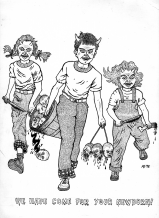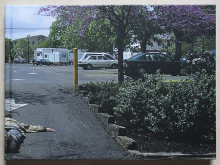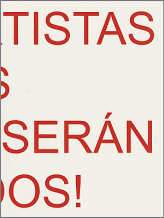| Revista Umělec 2009/2 >> Time Out Cities | Lista de todas las ediciones | ||||||||||||
|
|||||||||||||
Time Out CitiesRevista Umělec 2009/201.02.2009 Andreas Spiegl | public space | en cs de |
|||||||||||||
|
he first Time Out—a printed guide providing up-to-date cultural events in London—was published in 1968. Today, Time Out appears in over 30 cities around the world from Abu Dhabi to Zagreb, and defines itself on its web page as a “company…providing the latest, most reliable and informed information on what’s happening anywhere in the world”
This expansion isn’t merely due to the acknowledgement that things are happening in cities other than London, but because various cultural and popular events can be described similarly in cities anywhere in the world. Time Out carries information about art, theater, music, cinema, shopping, dining, and even sex. Simply put, “Time Out is an international multimedia publisher of cultural experiences for urban adventures.” It’s not only interesting that this self-description links cultural experiences with urban adventures, but that the title also manifests a figure of time: Time Out stands for downtime, for a break in schedule. As in sports, a “time-out” is requested from the normal order of things. Various forms of time-out can be for vacations to pleasant locales or simply weekends. The time-out acts as a legitimate break, a unit both within the context of rigid societal institutions and outside of it. In terms of an urban adventure, Time Out stands for an experience within the city that is also an escape from the city. In the free time associated with Time Out, you leave the city in order to really start your adventure. This time-out covers a broad spectrum—a city inside the city that can be discovered from the outside and from the inside at the same time. In 1967, a year before Time Out appeared, Michel Foucault wrote “Of Other Spaces.” In this text, Foucault outlines the concept of a heterotopia. “There are places that are outside of all other places, even though it may be possible to indicate their location in reality,” Foucault explains. “Because these places are absolutely different from all the sites that they reflect and speak about, I shall call them, by way of contrast to utopias, heterotopias.” Foucault uses a variety of examples to explain heterotopias, including a cemetery on the edge of a town, the cinema, the theater, museums, libraries, and ships. Heterotopias, he says, are “real places—places that do exist and that are formed in the very founding of society—which are something like counter-sites, a kind of effectively enacted utopia in which the real sites, all the other real sites that can be found within the culture, are simultaneously represented, contested, and inverted.” The scope of this question of heterotopias covers the spectrum of everyday activities. Fundamentally, spaces differ from other spaces and represent their own space at the same time. Foucault couples the question of the spaces of heterotopias with the question of time: “Heterotopias are most often linked to slices in time—which is to say that they open onto what might be termed, for the sake of symmetry, heterochronies. The heterotopias begin to function at full capacity when men arrive at a sort of absolute break with their traditional time.” There is a close tie between the notion of identifying the time-out signified with Time Out and the heterochronies described by Foucault. Even in its title, Time Out has advocated on its web page brochure, a “break from traditional time” for over 40 years with the goal of inspiring the reader to what Time Out calls a “lead a richer life” outside of traditional time and in the time that they have. The regularly updated Time Out cities, all around the world, are addressed as heterotopias. Time Out spotlights places and events that are real and completely tangible, but differs from Foucault, who focuses on investigating and analyzing these different spaces, and seems to have emancipated the heterotopias from specific localizations in order to identify different cities around the world with an urban identity per se. The plethora of Event and Place descriptions work only as a heterotopology of a given urban space, no matter where it is: Abu Dhabi, London, Paris, Zagreb, or Zürich—urban adventures anywhere in the world. Considering that Time Out’s localized events and happenings address a 24 hour time-out, it is synchronized with traditional time while acting as an absolute rupture from traditional time. The everyday urban adventure—the everyday time-out—not only defines the urban as a comprehensive heterotopia, but also raises the question of whether the heterotopic has switched sides and now appears where Foucault conjectured about traditional time and its related places—at the workplace during working hours, in public space, in the family, in politics, etc. It seems that what is left from the heterotopia is heterochronia, a form of time that can be described as a break in continuity: time-out as everyday thing. The break in continuity is disconnected only by figures of time, which we implicitly commemorate through work or politics that we can associate with social responsibilities. The promise, that one can connect with work, politics or the economy to lead a richer life, is displaced in the time-out according to the objectives described by Time Out. The decoupling exigencies appear decoupled from social or political requirements. As exigencies are decoupled, the decoupling of social or political demands appears to be the objective of the urban experience—anywhere in the world. The cultural notion identified by the phrase ‘cultural experiences’ speaks directly to urban adventures. Abenteuer in German or adventure in English etymologically symbolizes an event that happens to a subject which breaks with routine. The urban-ness addressed in Time Out presents the city as a realm of happenings full of all sorts of adventures. They are abundant and omnipresent and one can choose the adventures and selected cities as one pleases. The choices vary, though the scope of choices remains constant. The transformation of urban adventures and events is set as a constant variable, which becomes the everyday in Time Out. The flavor of the cities is not so much a question of geography or topology, but rather a question of time—for a space where time can be experienced outside the constraints of set rules: more heterochronic than heterotopic. The conditions for understanding urban everyday life as heterochronic in its uniformity of incidence can be understood as everyday life as well as a break in everyday life. Therefore, the subject, not the nature of the event, makes the decision between the everyday and adventure at a given moment when they identify the chronology of the everyday or the other time of the heterochronology. The event is not just arbitrary in nature, but is arbitrarily connected to the everyday and its exception, the time-out. The urban adventure and the normal routine of the city are parallel to a place and its heterotopia. In an attempt to develop an art critical of figure, Jacques Rancière identifies in Distribution of the Sensible (2006) as “reciprocal references of heterogenes in the order of the sensible.” Rancière continues: “I call the distribution of the sensible the system of self-evident facts of sense perception that simultaneously discloses the existence of something in common and the delimitations that define the respective parts and positions within it. A distribution of the sensible therefore establishes at one and the same time something common that is shared, as well as exclusive parts…It defines the visibility or invisibility in a common space and determines who has access to a communal language and who does not.” In the context we are dealing with the urban-ness would be the commonality. Rancière’s Distribution of the Sensible defines whether this urban-ness is to be understood as a place or its heterotopia, or as the everyday or heterochronology. In order to criticize this Distribution of the Sensible as a politi-cal act, Rancière postulates: Critical art must be, in its way, an art of indifference. It must be an art which determines a point in which knowing and not knowing, activity and passivity are equivalent.” “The politics of art moves within the aesthetic regime of the arts on the paradoxical basis of ‘freedom of indifference,’ that infers the identity of work and inactivity, movement and sedentariness, activity and passivity.” Urban-ness assumes a political role when urban-ness. The everyday means as much as the adventure, and the relationship between a place and its heterotopia, is only a Distribution of the Sensible. In its arbitrariness, it poignantly points to a different Distribution of Sensibilities—whether it be explaining urban-ness as a time-out or as a normal regime for the others. The difference between these two is based on the conception of time. In time and time-out—if you will, In Time and Time Out—are synchronous figures. Work becomes a kind of activity that differentiates itself from activities one does in one’s spare time because money is earned for work and spent in free time. As a result of the employment policy crisis, which has so far characterized the 21st century, the old definitions of work have returned. So an identity of job and individual or work and individuality emerges at the horizon of the highly valued Creative Industries agendas. The individual’s creativity, the desire for something and the subjectivity are seen as economic opportunities. The chronological parameters result in the fusion of working time and spare time. It is known that the precarious conditions, under which this self-chosen fusion is executed, will be legitimatized as an investment. The bourgeois and entrepreneurial aspects of those investors should be excluded this time. What is left is an amalgam of working time and spare time less dependent on the resulting praxis than on the subject, which intends and wants it to be known that this praxis is here known as work and there as leisure activity. Time Out and In Time merge. The arbitrariness of both is its political capital. The platform for this amalgam of every day life and heterochronia displays a perception of urban-ness emancipated from the city that it appears in. From the perspective of Time Out and Cultural Industries, urban-ness stands for a kind of meta-urban-ness, addressed in different cities around the world. By turning urban-ness into meta-urban-ness, as paradoxical as it sounds, the city loses its urban-ness. What’s left of the city is its administration, or better put, administration problems, in relation to such questions as of migration, health, education, and waste management. If contemporary cities have built their image on meta-urban-ness, then they also propel a clear distinction between the city and urbanity. In order to promote urbanity as such, the city and its problems are thrust into the background. The city itself—to paraphrase Foucault—disappears into heterotopia. As for Time Out Cities politics, migration, health and refuse represent merely an interruption of the urban; heterochronies refer just to the city in order to normalize the urban as permanently interrupted mundanity. The Distribution of the Sensible, as outlined by Rancière, is at work here as well. But it is not artistic; so the distribution, of the city and urbanity, works on an arbitrariness that forwards the question to the individual, if the one and the same scene could be seen as a problem of migrants integrating into the city or as a contribution to the cultural diversity of the urban. Time Out.
01.02.2009
Artículos recomendados
|
|||||||||||||
|
04.02.2020 10:17
Letošní 50. ročník Art Basel přilákal celkem 93 000 návštěvníků a sběratelů z 80 zemí světa. 290 prémiových galerií představilo umělecká díla od počátku 20. století až po současnost. Hlavní sektor přehlídky, tradičně v prvním patře výstavního prostoru, představil 232 předních galerií z celého světa nabízející umění nejvyšší kvality. Veletrh ukázal vzestupný trend prodeje prostřednictvím galerií jak soukromým sbírkám, tak i institucím. Kromě hlavního veletrhu stály za návštěvu i ty přidružené: Volta, Liste a Photo Basel, k tomu doprovodné programy a výstavy v místních institucích, které kvalitou daleko přesahují hranice města tj. Kunsthalle Basel, Kunstmuseum, Tinguely muzeum nebo Fondation Beyeler.
|
































 New book by I.M.Jirous in English at our online bookshop.
New book by I.M.Jirous in English at our online bookshop.
Comentarios
Actualmente no hay comentariosAgregar nuevo comentario